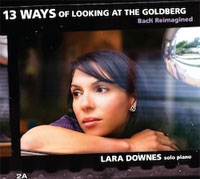13 Ways of Looking at the Goldberg
“13 Ways of Looking at the Goldberg” is a set of new pieces inspired by the aria of the Goldbergs, the piece that is the subject of the original variations themselves. Twelve composers were commissioned to write these solo piano works by the Gilmore International Keyboard Festival in 2004, where they were originally played by the pianist Gilbert Kalish.
No one variation exceeds 4 minutes. From baroque tinged to unmistakably Chopin to fugal, the variations on the Goldbergs take the listener’s lens on the iconic pieces and throw it into an entirely different realm. Pianist Gilbert Kalish then arranged the collection for its debut as a whole work, adding Bach’s theme to the beginning and to the end, and inserting Bach’s Variation 13 in the middle.
However, Kalish clearly states it is up to the pianist to decide how to perform these works, whether as a whole or specific movement(s) only.
In September 2011 Tritone Records announced the World Premiere release of 13 WAYS OF LOOKING AT THE GOLDBERG – new re-imaginings of Bach’s iconic Goldberg Variations by today’s most remarkable composers.
Hear pianist Lara Downes play and talk about the project:
Listen to four free tracks from the album.
 Piano Street caught up with Lara Downes for six short questions on the project and album “13 Ways of Looking at the Goldberg”:
Piano Street caught up with Lara Downes for six short questions on the project and album “13 Ways of Looking at the Goldberg”:
Patrick Jovell: As we have seen on the video, you were virtually raised on The Goldberg Variations. How is it that particularly this work has earned such historic landmark status in western art music?
Lara Downes: The Goldberg Variations are important in so many ways. For one thing, the piece is considered to be the most ambitious work ever composed for harpsichord, so it stands out as a monument of its own time, as the largest keyboard work produced during the Baroque period.
The piece exists on a level that is radically different from its contemporary compositions in terms of its structural expansiveness.
PJ: Isn’t it true that this work demonstrates not only Bach’s exceptional musical range but also his exceptional abilities as a performer?
LD: Ironically, it is exactly this virtuosic scope and breadth that may have condemned the work to relative obscurity for so many years. The work demands exceptional interpretive and technical skills from a performer, and the negotiations involved in transitioning a work originally composed for the harpsichord to the modern piano would have been particularly sensitive on this large scale.
PJ: Can you describe the work’s path from obscurity up to the grand concert stages?
LD: After Wanda Landowska’s pioneering revival of Bach’s keyboard music in the early part of the 20th century (during which she performed and recorded the Goldbergs on the harpsichord), it fell to Glenn Gould, who chose the variations for his sensational 1955 debut recording, to bring the work to its current place of truly iconic status within the piano repertoire as well as the larger cultural consciousness.
PJ: What actually happened to the work in the hands of Gould’s?
LD: Gould’s energetic, audacious and thoroughly unique interpretation generated a new kind of appreciation for Bach’s music by combining the sensibilities of the harpsichord with the romantic potential and expanded resources of the concert grand. His recording captured the imagination of an entire generation, and brought the Goldbergs, and classical music itself, to life for thousands of new listeners.
PJ: How would you sum up the potential of this masterpiece?
LD: I think it’s the capacity of this work for reinvention and rejuvenation that has earned the Goldbergs such landmark status in the classical tradition. This music seems to speak to generation after generation with a sustained purity, energy and sense of vastness. This is what captures me and keeps me coming back, time and again, to this one piece of music. When I listen to the Goldbergs, I forget about my individual concerns, troubles, perspectives – and I enter a sphere of infinite possibility and vision.
PJ: In this context the contributing composers were both historically inspired and thankful, I guess?
LD: 13 WAYS of Looking at the Goldberg is, to me, a wonderful acknowledgment of that possibility. This project celebrates the history of Bach’s monumental piece of music, its journeys across the centuries and the generations. In thirteen new voices, this music answers back across time and place to Bach, with all the gratitude and affection that
we musicians owe him, now and always.
The project was inspired by the poem “Thirteen Ways of Looking at a
Blackbird” by Wallace Stevens, a minimalist and mind-blowing portrait of
perspective. The fifth stanza of that poem includes the basic idea of
the “13 Ways” project:
I do not know which to prefer,
The beauty of inflections
Or the beauty of innuendoes,
The blackbird whistling
Or just after.
The pieces:
Bach: Aria, from Goldberg Variations BWV 988
C. Curtis-Smith: Rube Goldberg Variation
Jennifer Higdon: The Gilmore Variation
Mischa Sarche Zupko: Ghost Variation
Stanley Walden: Fantasy Variation
Bright Sheng: Variation Fugato
Derek Bermel: Kontraphunktus
Bach: Variation 13 from Goldberg Variations
David Del Tredici: My Goldberg (Gymnopedie No. 1)
Fred Lerdahl: Chasing Goldberg
William Bolcom: Yet Another Goldberg Variation (for left hand alone)
(Canon Inversa)
Lukas Foss: Goldmore Variation
Ralf Gothoni: Variation on Variation with Variation
Fred Hersch: Melancholy Minuet
Bach: Aria (reprise) from Goldberg Variations
Links:
Hear samples from the album at Amazon.com
Get the scores at Edition Peters
Pianist Lara Downes website
Comments